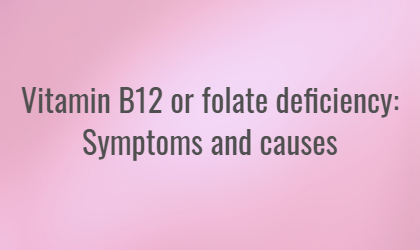
If you’ve ever had a blood test, you might have encountered the term ‘ferritin’ before. Ferritin has a unique relationship withiron – a mineral that contributes to the reduction of tiredness and fatigue, and to the normal function of the immune system. And so, when your ferritin levels are low, your body struggles to operate optimally.
What is ferritin?
It can be helpful to think of your body as a well-stocked larder. Alongside the perishables that you eat every day, it also contains tins of beans and bags of rice when supplies run low.
Your body stores iron in a similar way: it uses up some of the iron from the food you eat to make oxygen in your blood, but it also saves some for a ‘rainy day’ when you aren’t getting as much iron from food.
Ferritin is a complex protein that stores iron in your cells, releasing it when the body needs it – to produce red blood cells, amongst other things. Your liver contains the highest concentrations of ferritin.
Having healthy iron and ferritin levels are equally important. Without this, your iron status may decline rapidly.
Low ferritin symptoms
The following symptoms are often associated with low ferritin levels:
-
Shortness of breath
-
Irritability
-
Dizziness
-
Unexplained fatigue
-
Ringing in your ears
-
Pale, dry skin
-
Heart palpitations
-
Increased hair shedding
Low ferritin causes
Low ferritin levels may signal that you have an iron deficiency, often resulting from an inadequate dietary intake of iron. This is especially true if you’re vegetarian or vegan.
Aside from this, other causes of low ferritin levels include:
-
Excessive menstrual bleeding
-
Exercising excessively
-
Pregnancy
What’s the difference between low iron stores (low ferritin levels) and iron-deficiency anaemia?
Although low iron stores and iron-deficiency anaemia share similar symptoms – shortness of breath, fatigue, weakness, dizziness, pale skin, and heart palpitations – they’re two different biological events (1). (Link to article: iron-deficiency anaemia: symptoms and causes)
Anaemia is caused by a lack of haemoglobin – a substance red blood cells produce to transport oxygen around the body (2). Low iron stores, on the other hand, are caused by a lack of iron.
This means that if you had low iron stores, but your haemoglobin and full blood count were normal, you would have an iron deficiency, not anaemia (3). Indeed, your iron stores can be low even when haemoglobin is normal since iron stores will be sacrificed to ensure haemoglobin remains at a healthy level.
But if both your iron stores and haemoglobin were low, it would indicate that you have an iron deficiency and iron-deficiency anaemia (4).
It’s also worth mentioning that within anaemia as a broader term, there can also be vitamin B12 or folate deficiency anaemia, both of which are unrelated to the body’s iron status.
Ferritin blood test
Ferritin is a helpful indicator of how much iron is in the body. If your GP believes you may be experiencing an iron deficiency, they will book you in for a ferritin blood test. The higher the concentrations of ferritin in your body, the more stored iron you have.
Preparation: Should I fast before a ferritin blood test?
You don’t need to fast if your blood sample is just being tested for ferritin, so you can drink and eat normally before a ferritin blood test.
Results: What is the normal range for ferritin levels?
The following results are a normal range for blood ferritin (5):
-
For women: 11 to 307 micrograms per litre
-
For men: 24 to 336 micrograms per litre
A low ferritin result may signal that you have an iron deficiency. You may also have iron-deficiency anaemia. With this knowledge, your GP will work with you to understand the cause.
How to increase ferritin levels
Dietary changes
Increasing the quality and quantity of dietary iron is the best way to increase your ferritin levels and overall iron status.
There are two types of iron: haem (from animal sources) and non-haem (from plant sources). Notably, the body absorbs haem iron much better. But haem iron can support the absorption of non-haem iron (6). To improve your iron status, therefore, consider eating a serving of each at any one time – steak with spinach, for instance.
Haem iron sources
-
Beef (red meat contains more haem iron than poultry)
-
Lamb
-
Pork
-
Fish
-
Poultry
Non-haem iron sources
-
Pulses
-
Legumes
-
Dark leafy vegetables
-
Tofu
-
Nuts
-
Seeds
If you’re on a plant-based diet, you’ll need to eat more non-haem iron, especially if you lose iron-containing blood each month during menstruation. Cooking and soaking nuts and seeds can enhance iron absorption (7). (Link to article: Women and anaemia)
Vitamin C may also support iron uptake. With this in mind, try eating a vitamin C source, like citrus fruits or green leafy vegetables, with iron-rich foods.
Iron supplements
Besides upping your dietary iron intake, taking a quality iron supplement can cover any nutritional shortfalls you may encounter. And if you can find a multivitamin formula with vitamin C to support iron absorption, that’s even better.
Try to choose a formula that delivers between 7mg-20mg of iron, depending on your age and gender.
-
Teenage girls (11-18 years) need 14.8mg daily
-
Teenage boys (11-18 years) need 11.3mg daily
-
Women (19-50 years) require 14.8mg daily
-
Men (19-50 years) require 8.7mg daily
-
Those above 50 years need 8.7mg daily
If your ferritin levels are low, don’t worry. With the right dietary changes and guidance from your GP, you can easily replenish your lost stores. Head back to our dedicated blog to learn more about how iron supports your health and wellbeing.
References
- Mayo Clinic. 2021. Anemia - Symptoms and causes. [ONLINE] Available at: https://www.mayoclinic.org/diseases-conditions/anemia/symptoms-causes/syc-20351360
- nhs.uk. 2021. Red blood cell count. [ONLINE] Available at: https://www.nhs.uk/conditions/red-blood-count/
- Soppi E. T. (2018). Iron deficiency without anemia - a clinical challenge. Clinical case reports, 6(6), 1082–1086.
- Irondisorders.org. 2021. Iron Deficiency Anemia Iron Disorders Institute. [ONLINE] Available at: https://irondisorders.org/iron-deficiency-anemia/
- Mayoclinic.org. 2021. Ferritin test - Mayo Clinic. [ONLINE] Available at: https://www.mayoclinic.org/tests-procedures/ferritin-test/about/pac-20384928
- Bda.uk.com. 2021. Iron. [ONLINE] Available at: https://www.bda.uk.com/resource/iron-rich-foods-iron-deficiency.html
- Bda.uk.com. 2021. Iron. [ONLINE] Available at: https://www.bda.uk.com/resource/iron-rich-foods-iron-deficiency.html
Related Posts
Disclaimer: The information presented by Nature's Best is for informational purposes only. It is based on scientific studies (human, animal, or in vitro), clinical experience, or traditional usage as cited in each article. The results reported may not necessarily occur in all individuals. Self-treatment is not recommended for life-threatening conditions that require medical treatment under a doctor's care. For many of the conditions discussed, treatment with prescription or over the counter medication is also available. Consult your doctor, practitioner, and/or pharmacist for any health problem and before using any supplements or before making any changes in prescribed medications.

Keri
Keri Filtness has worked in the Nutrition Industry for 19 years. She is regularly called upon for her professional comments on health and nutrition related news. Her opinions have been featured by BBC3, Prima, Vitality, The Mirror, Woman’s Own and Cycling Weekly, amongst others. She has also worked one to one with journalists, analysing their diets and health concerns and recommending changes and additions, where appropriate.



